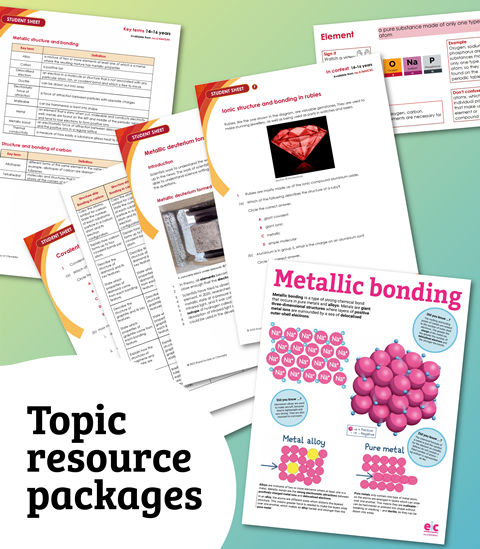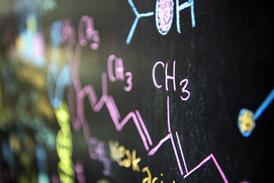All RSC Education articles in Non-EiC content – Page 55
-
 Class experiment
Class experimentA visible activated complex
A simple demonstration of catalysis also introducing the idea of an activated complex and to allow discussion of the mechanism of catalysis. Includes kit list and safety instructions.
-
 Class experiment
Class experimentHydrogen peroxide decomposition using different catalysts
Collect a range of catalysts to explore the decomposition of hydrogen peroxide, paying close attention to the varied reaction rates. Includes kit list and safety instructions.
-
 Class experiment
Class experimentCompetition for oxygen | reacting metals with oxides
Explore the reactions of metals when exposed to the oxide of another metal. When reactions like these occur, the two metals compete for the oxygen. Includes kit list and safety instructions.
-
 Class experiment
Class experimentElectrolysis of potassium iodide solution
Find out how the electrolysis of a potassium iodide solution works with this practical. Includes kit list, and safety instructions.
-
 Class experiment
Class experimentAn alternative to using compressed gas cylinders
Getting gas under pressure allows exciting demonstrations such as igniting balloons filled with hydrogen gas. Includes kit list and safety instructions.
-
 Class experiment
Class experimentMaking nylon: the ‘nylon rope trick’
The ‘nylon rope trick’ is a classic of chemistry classrooms, by mixing decanedioyl dichloride and in cyclohexane you can create a solution that will form nylon strings when floated on an aqueous solution of 1,6-diaminohexane. Kit list and safety instructions included.
-
 Class experiment
Class experimentFlame tests (the wooden splint method)
Find a new method to perform flame tests using wooden splints soaked in chlorides. Includes kit list and safety instructions.
-
 Class experiment
Class experimentNeutralisation circles
Support students to explore neutralisation circles in this experiment that can be performed with common chemistry classroom equipment. Kit list and safety instructions included.
-
 Class experiment
Class experimentThe methane rocket
Ignite methane with oxygen in a bottle, and amaze students with this methane rocket. Contains kit list and safety instructions.
-
 Class experiment
Class experimentExtracting limonene from oranges
Limonene is found in oranges, and now your classroom. Create a distillation apparatus and support students to make their own plant oils. Includes kit list and safety instructions.
-
 Class experiment
Class experimentThe effect of concentration on reaction rate
Students react sodium thiosulfate solution is reacted with acid – a sulfur precipitate forms. The time taken for a certain amount of sulfur to form can be used to indicate the rate of the reaction. Contains kit list and safety instructions.
-
 Class experiment
Class experimentDiffusion of gases – a safer alternative to bromine
Diffusing gases can be a tricky thing to do, but by creating an alternative to bromine, you can make a safer classroom alternative for this process. Kit list and safety instructions included.
-
 Class experiment
Class experimentMaking silicon and silanes from sand
Create silicon in your classroom using just sand and magnesium. This exothermic practical will show learners the nuances of heat based reactions and how to perform them safely. Kit list and safety instructions included.
-
 Class experiment
Class experimentReduction of copper(II) oxide by hydrogen
Determine the formula of copper(II) oxide by reducing it using hydrogen or methane, in one of three methods available to you in this practical. Includes kit list and safety instructions.
-
 Class experiment
Class experimentTesting for negative ions
Guide students into testing for negative ions with this practical. Students note their own observations and use their knowledge to discover more. Includes kit list and safety instructions.
-
 Class experiment
Class experimentCross-linking polymers – alginate worms
With a collection of equipment easy to find in your classroom, learners can form alginate polymer ‘worms’ and explore cross-linking polymers
-
 Resource
ResourcePlant science practicals
A collection of experiments that cover a number of topics that help students learn and understand the physical and chemical processes that occur in plants. Such as, how water is taken up by plants; how cellulose facilitates passive transport; and the how changes in the concentrations of nutrients in soil, affects plant growth.
-
 Resource
ResourceChallenging Plants: Soil Science - Practicals
The nature of soil particles (inorganic and organic) and of soil water affects plant growth and, in particular, the availability of nutrients essential for the growth of quality crops in high yield. An understanding of the media in which plants grow helps scientists to exploit their potential.
-
 Resource
ResourceChallenging Plants: Fertilisers - Practicals
Nutrients essential for plant growth are obtained naturally from soil or other growing media. However, supplies become depleted and fertilisers are needed to increase the availability of nutrients to plants. An understanding of chemical changes is used to making fertilisers, often designed to meet specific requirements such as particular nutrient ...
-
 Resource
ResourceChemhistory: mauveine
Professor Alan Dronsfield, chair of the Royal Society of Chemistry’s Historical Group, looks at the significance of mauveine in a historical context.











